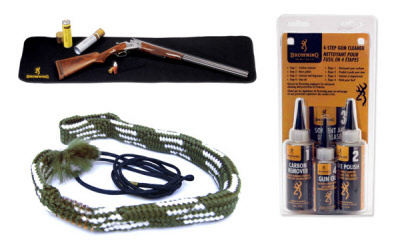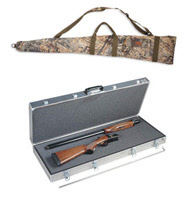Firearm Cleaning and Maintenance Guide
Cleaning your weapon is the most important step you can take to prevent jams and ensure a long life of service. Whether you’re firing a handgun, a shotgun, or a rifle, cleaning it regularly is essential to its performance. Cleaning isn’t very difficult either, it takes all of about 30 minutes and allows you to closely inspect your weapon. This guide will cover the basics to cleaning and maintaining your weapon; from essential accessories, to what causes a weapon failure, to a step by step list that every gun owner should know by heart.


Essential Firearm Supplies
Before you clean your weapon, before you even fire it, be sure to get a few essential supplies. Proper weapon maintenance means caring for your weapon before, during, and after you use it.
Before: If you plan to transport your weapon at all (we hope you’ll take it out of the house eventually) you might want to invest in a case, sock, or bag. A hard case can protect your weapon and delicate optics during transport. Even a flexible case can prevent scratches and dents that might damage the finish. A gun sock locks out moisture and helps protect your weapon from corrosion.
During: Whether you plan to hide out in a blind or post up in a tree stand, a good sling will keep your weapon close when you need it and out of the way when you don’t. As long as your weapon is nearby you’ll know that it’s safe.
After: Cleaning your weapon after each use is an essential step in proper weapon maintenance. By cleaning your weapon you can prevent residue build up and check for various forms of damage. A simple 4 Step Gun Cleaning Kit is all you need for basic care, and can last years depending on how often you fire your weapon. But for thorough cleaning and precise work you might want to consider an All Purpose Cleaning Kit.
Whatever weapon you use; handgun, rifle, or shotgun, be sure to care for it every step of the way with these essential supplies.
What Causes a Weapon Failure
A weapon failure can be caused by a number of problems. A mechanical error like a damaged firing pin can prevent the round from firing, while a damaged magazine lip may cause the round to be misaligned as it is loaded into the chamber. The most common cause of a weapon failure, so long as the weapon is being handled properly, is a dirty chamber. But how did it get dirty?
When the round fires small amounts of gunpowder residue fly everywhere, coating the internals of the weapon. As the round is propelled down the barrel, small amounts of the projectile are shaved off, these, and bits of gunpowder from earlier, coat the inside of the barrel.
The more rounds you fire, the more residue builds up in the weapon. Large amounts of residue can prevent the weapon from firing properly. This could cause any number of problems; the expended shell may not properly eject, the new round may not feed, etc. By cleaning your weapon after each use, and inspecting it carefully to ensure the proper operation of each component, you can help to prevent weapon failures. A clean weapon may be the difference between a trophy buck and an empty table, or even worse, life and death.
The Eight Simple Steps You Need to Know
Before you do literally anything, CHECK THE WEAPON. You can prevent accidental firearm discharge, increase safety, and save lives by CHECKING THE WEAPON BEFORE YOU DO ANYTHING. Until you determine the weapon is clear – and even after – treat it as if it is loaded. These might seem like beginners rules but according to the CDC there were 505 accidental deaths involving a firearm in 2013. So please, check your weapon.

Step One: Partially Disassemble the Firearm
Most weapons come with an instruction manual regarding disassembly. If you don’t have one, you can buy one from most gun stores, or try to find one online.
Step Two: Inspect and Clean the Weapon
Carefully inspect the weapon for any dents, dings, or other flaws that could hinder operation. With a clean rag, wipe down all metal. You can also use a solvent to remove any build up. Use a brush to remove any leftover residue from the receiver. Do not use a metal brush, this will damage the weapon.
Step Three: Clean the Barrel
Drop the barrel solution on the cloth swabs that came with your gun cleaning kit. Use the rod to push the cloth all the way down the barrel to the receiver. Don’t pull the cloth back through, as this would bring more residue back through the barrel you just cleaned. Repeat this step as many times as you see fit.
Step Four: Clean Other Components
Feel free to clean other parts of the weapon, like the bolt or magazine. This process is identical to Step Two.
Step Five: Treat Stock
If you have a wooden stock, common on many bolt action rifles and shotguns, feel free to treat the stock with oil or wood cleaner. This step isn’t necessary, but many people choose to do it for aesthetic purposes, and may extend the life of the stock.
Step Six: Apply Rust Protector
Apply a rust protector to any exposed metal. This will protect your weapon from future corrosion.
Step Seven: Apply Lubricant
Apply lubricant to any metal that slides together. Many people choose to use a q-tip for this step. Be sure not to get any bits of cotton on the freshly cleaned weapon.
Step Eight: Reassemble
Once you’re done, reassemble the weapon and ensure everything is operating properly.
Properly Storing Firearms
Cleaning your weapon will ensure it has a long life and always performs the way it should. Now that you’ve spent time cleaning your weapon, it’s time to store it away until you use it next. We have a handy buyers guide to help you find the safe you need. But if you already know what you’re looking for, check out our selection of safes, truck vaults, and shotlocks.

